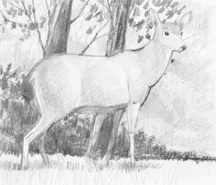 |
Earth Journal by Gary Pendleton |
Deer Among Us
When biological carrying capacity and cultural carrying capacity clash
I had my close encounter with a deer a few autumns ago while driving west on Rt. 260, heading out of Chesapeake Beach. The deer came across the shoulder from the right and tried to cross the road. Instead, it struck the side of my car and bounced off. I stopped but the deer was gone, leaving a minor mark on the paint and a wet smudge where its nose must have struck the window.
The road was dry and a few seconds in the deer’s crossing were on my side. I don’t know how the deer fared.
Forgive me for the use of a little tech-speak now. Biological carrying capacity is a concept used to describe an environment’s capacity to support life in a given habitat, no matter how large or how small. The rise in population of such species as black bear, coyote, Canada geese and deer has led to a second category. Cultural carrying capacity refers to society’s ability and willingness to tolerate the presence of Bambi, Smokey, Wiley and the goose.
Deer are wildlife at its most popular. People appreciate deer for their beauty and grace. Hunters like deer for their sport and as food.
Yet everybody knows that deer damage crops and gardens. They are not just a nuisance but also a potentially deadly and costly one. Deer cause car accidents, and some of those are very serious. Deer also carry ticks that carry Lyme disease.
The cultural carrying capacity goes down when society feels threatened or annoyed. Statistics for deer-related damages are impressive, but I won’t quote them. We all understand.
I’m sorry, but it is hard for me to write about deer in a more positive way. I try to picture images of deer posed majestically in a corn stubble field by the edge of the forest bathed in golden light. But mental images of deer carcasses on the roadside keep interrupting.
Early settlers eliminated the wolves and lions as threats and competition to human life and livelihood. By the 1930s, deer were also practically eliminated, but wildlife management helped restore the population. Now we face new and unforeseen threats but are unsure and conflicted about how to manage them.
Many people are drawn to landscapes of field and forest. Something deep within us responds to the same type of habitat that deer thrive in, and we want to live there. Wilderness and wildlife help us feel sane and whole. Thinking these thoughts helps to boost my personal cultural carrying capacity for deer and helps to keep away the ugly roadside images that want to intrude into my brain. That is the best I can do for now.